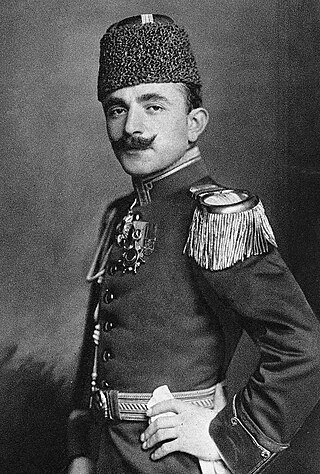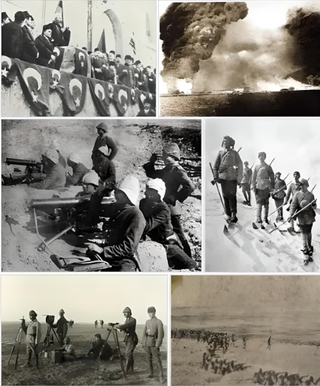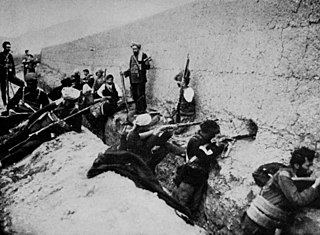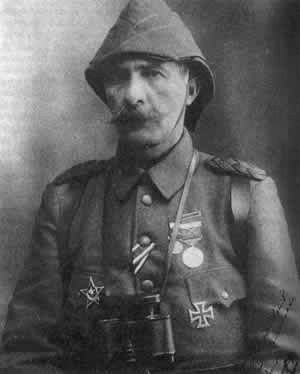
The First Balkan War lasted from October 1912 to May 1913 and involved actions of the Balkan League against the Ottoman Empire. The Balkan states' combined armies overcame the initially numerically inferior and strategically disadvantaged Ottoman armies, achieving rapid success.

İsmail Enver, better known as Enver Pasha, was an Ottoman military officer, revolutionary, and convicted war criminal who formed one-third of the dictatorial triumvirate known as the "Three Pashas" in the Ottoman Empire.

The military of the Ottoman Empire was the armed forces of the Ottoman Empire.

The Battle of Ctesiphon was fought in November 1915 by the British Empire, against the Ottoman Empire, within the Mesopotamian Campaign of World War I.

The Mesopotamian campaign or Mesopotamian front was a campaign in the Middle Eastern theatre of World War I fought between the Allies represented by the British Empire, troops from Britain, Australia and the vast majority from British Raj, against the Central Powers, mostly the Ottoman Empire. It started after British amphibious landings in 1914 which sought to protect Anglo-Persian oil fields in Khuzestan and the Shatt al-Arab. However, the front later evolved into a larger campaign that sought to capture the key city of Baghdad and divert Ottoman forces from other fronts. It ended with the Armistice of Mudros in 1918, leading to the cession of Iraq and further partition of the Ottoman Empire.

The Middle Eastern theatre of World War I saw action between 30 October 1914 and 30 October 1918. The combatants were, on one side, the Ottoman Empire, with some assistance from the other Central Powers; and on the other side, the British as well as troops from the British Dominions of Australia, Canada, and New Zealand, the Russians, and the French from among the Allied Powers. There were five main campaigns: the Sinai and Palestine, Mesopotamian, Caucasus, Persian, and Gallipoli campaigns.
The Three Pashas, also known as the Young Turk triumvirate or CUP triumvirate, consisted of Mehmed Talaat Pasha, the Grand Vizier and Minister of the Interior; Ismail Enver Pasha, the Minister of War and Commander-in-Chief to the Sultan; and Ahmed Djemal Pasha, the Minister of the Navy and governor-general of Syria, who effectively ruled the Ottoman Empire after the 1913 Ottoman coup d'état and the subsequent assassination of Mahmud Shevket Pasha.

The defense of Van was the armed resistance of the Armenian population of Van against the Ottoman Empire's attempts to massacre the Ottoman Armenian population of the Van Vilayet in the 1915 Armenian genocide. Several contemporaneous observers and later historians have concluded that the Ottoman government deliberately instigated an armed Armenian resistance in the city and then used this insurgency as the main pretext to justify beginning the deportation and slaughter of Armenians throughout the empire. Witness reports agree that the Armenian posture at Van was defensive and an act of resistance to massacre. The self-defense action is frequently cited in Armenian genocide denial literature; it has become "the alpha and omega of the plea of 'military necessity'" to excuse the genocide and portray the persecution of Armenians as justified.

Ottoman labour battalions was a form of unfree labour in the late Ottoman Empire. The term is associated with the disarmament and murder of Ottoman Armenian soldiers during World War I, of Ottoman Greeks during the Greek genocide in the Ottoman Empire and also during the Turkish War of Independence.

Ottoman casualties of World War I were the civilian and military casualties sustained by the Ottoman Empire during the First World War. Almost 1.5% of the Ottoman population, or approximately 300,000 people of the Empire's 21 million population in 1914, were estimated to have been killed during the war. Of the total 300,000 casualties, 250,000 are estimated to have been military fatalities, with civilian casualties numbering over 50,000. In addition to the 50,000 civilian deaths, an estimated 600,000 to 1.5 million Armenians, 300,000 to 750,000 Greeks, and 300,000 Assyrians,lebanese Maronites 200,000 were systematically targeted and killed by Turkish authorities either via the military or Kurdish gangs. Likewise, starting in 1916, Ottoman authorities forcibly displaced an estimated 700,000 Kurdish people westward, and an estimated 350,000 died from hunger, exposure, and disease.

Ahmed Izzet Pasha, known as Ahmet İzzet Furgaç after the Turkish Surname Law of 1934, was an Ottoman general during World War I. He was also one of the last Grand Viziers of the Ottoman Empire and its last Minister of Foreign Affairs.
The Second Army of the Ottoman Empire was one of the field armies of the Ottoman Army. It was formed in the late 19th century during Ottoman military reforms.

The Aviation Squadrons of the Ottoman Empire were military aviation units of the Ottoman Army and Navy. The history of Ottoman military aviation dates back to June 1909 or July 1911. The organisation is sometimes referred to as the Ottoman Air Force. The fleet size reached its apex in December 1916, when the Ottoman aviation squadrons had 90 airplanes. The Aviation Squadrons were reorganized as the General Inspectorate of Air Forces on 29 July 1918. With the signing of the Armistice of Mudros on 30 October 1918, the Ottoman military aviation effectively came to an end. At the time of the armistice, the Ottoman military aviation had around 100 pilots; 17 land-based airplane companies ; and 3 seaplane companies ; totalling 80 aircraft.

Hafiz Hakki Pasha, was an officer in the Ottoman Army who rose to the rank of Major General. He commanded troops during the Balkan Wars and the First World War.
Edward J. Erickson is a retired regular U.S. Army officer at the Marine Corps University who has written widely on the Ottoman Army during World War I. He is an associate of International Research Associates, Seattle, Washington and as of July 2016 was also listed as an advisory board member of the Ankara-based, Turkish government aligned think-tank, Avrasya Incelemeleri Merkezi (AVIM), which goes by the English name Center for Eurasian Studies.
The Eighth Army of the Ottoman Empire was one of the field armies of the Ottoman Army. It was established during World War I.

The XV Corps of the Ottoman Empire was one of the corps of the Ottoman Army. It was formed during World War I.

Mehmet Esat Bülkat was an Ottoman Army officer who fought during the First Balkan War, where he led the Yanya Corps, and in World War I, where he served as a senior commander in the Gallipoli campaign. Prior to the 1934 Surname Law, he was known as Mehmed Esad Pasha.

The Ottoman Army was the army of the Ottoman Empire after the country was reorganized along modern western European lines during the Tanzimat modernization period. It operated during the decline and dissolution of the empire, which roughly occurred between 1861 and 1918, the end of World War I for the Ottomans. The Crimean War was the first war effort in which the modern army took part in, proving itself as a decent force. The last reorganization occurred during the Second Constitutional Era.

Erik-Jan Zürcher is a Dutch Turkologist. He is a professor of Turkish studies at Leiden University since 1997. From 2008 to 2012 he served as director of the International Institute of Social History. His book Turkey: a Modern History is considered a standard work. Zürcher frequently comments on current issues related to Turkey.















